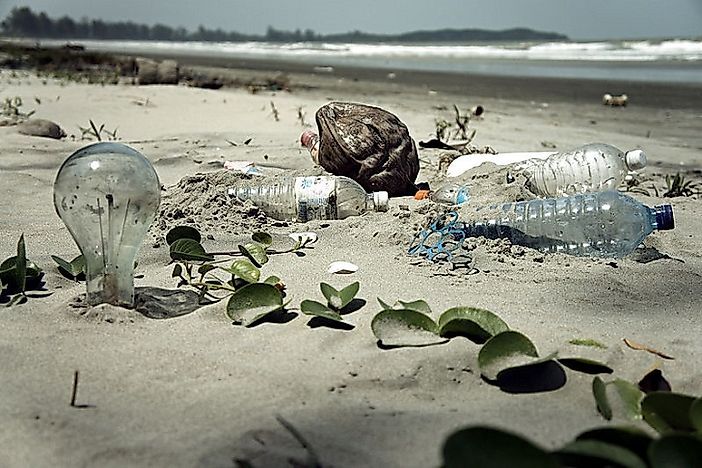Oceanic currents have caused trash to accumulate over this large area of the Pacific Ocean.
5. Size and Location
Evidence of the careless action of man, a massive gyre of marine debris in the central North Pacific Ocean is a great concern for the environmentalists of the world. Known as the Great Pacific Garbage Vortex, this patch of debris in the Pacific Ocean spans the latitudes between 35° North and 42° North, and longitudes between 135° West and 155° West. Though the debris particles in the vortex are not visible from space and neither visible to those boating or diving in the ocean, due to the extensive breakdown of the debris by wind and water currents and its distribution across a vast area, it reality it represents large concentrations of plastics, chemical wastes and other garbage that has become trapped within the oceanic currents of the Pacific Ocean.
4. Formation
Scientists of the world estimate that the Great Pacific Garbage Patch formed over a long period of time. As contaminants from the continents were released into the oceans, the wind driven currents forced these debris to move towards the heart of the ocean. During this process, the garbage got broken down into smaller particles often up to microscopic sizes. Soon, the garbage collected within a gyre in a relatively stable zone in the middle of the ocean. The gyre’s typical rotational force sucked in the surrounding debris, forcing the debris to remain trapped within its core.
3. Discovery and Monitoring
The first indication of the existence of the Great Pacific Garbage Vortex was found in a 1988 paper published by the National Oceanic and Atmospheric Administration (NOAA) of the United States, which based its results on studies obtained from several other previous reports of such occurrences in the oceans of the world. The wide scale media attention towards this garbage patch was however triggered by Charles J. Moore, a racing boat captain and oceanographer in 1999 when he claimed that he had witnessed large patches of debris in the Pacific Ocean while participating in a sailing race. Since then, media has been portraying the Great Pacific Garbage Patch as one of the most devastating impacts of man on marine environments. Currently, several environmental and non-profit organizations of the world have been monitoring the Great Pacific Garbage Patch, studying its size, formation, growth and impact to warn the public of the ill effects of marine pollution.
2. Environmental Effects

The pollutants of the Great Pacific Garbage Vortex spells doom for the marine inhabitants of the Pacific Ocean. The suspension of debris near the surface of the ocean effectively blocks sunlight from reaching the plankton and algae below the water’s surface. The decreased growth and multiplication of these plankton and algae affects the entire food chain of the marine ecosystem. Fishes, turtles and marine species dependent on these autotrophs for their food sources undergo a reduction in populations sizes and in turn, the larger aquatic species like whales, sharks, larger fish which feed on the smaller marine animals also start dying due to starvation, malnutrition and stress. The plastic debris of the garbage patch also gradually breakdown by the process of photo-degradation, releasing toxic chemicals like bisphenol A into the water which also has an adverse impact on marine organisms. Man is also ultimately impacted by the marine pollution as now there is less fish available in the ocean leading to skyrocketing prices of fishes in the market and toxins also enter the human body in large amounts based on the concept of biomagnification.
1. Cleaning It Up
Cleaning up the Great Pacific Garbage Patch is not an easy job. As per some estimates 67 ships working for a whole year can clean up only 1% of the Pacific Ocean. Since the garbage patch is so remotely located, it is impossible to hold a single country responsible for this source of pollution and hence no one is ready to take up the responsibility of cleaning up the mess. Environmentalists also claim that cleaning up the debris would require brand new technologies. The best thing that can be done under the present circumstances is thus to check further growth of the garbage patch by discarding the use of toxic plastics and replacing it with biodegradable materials.
For more information visit https://www.worldatlas.com/articles/the-great-pacific-garbage-vortex.html
